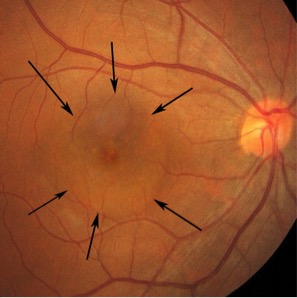What is central serous retinopathy?
Central Serous Retinopathy (CSR) is an eye condition, which can cause temporary visual impairment that usually affects one eye. It is a disorder of the retina characterised by the build up of fluid within the macula (the central part of the retina).
Symptoms
Patients describe a rapid onset blurring of their central vision, seeing a grey patch or washed out colours or central distortion in one eye. The vision can be severely affected in some patients. It is rare for both eyes to be affected.
Causes
The cause is often unknown but does have a tendency to affect young to middle aged men who may have been exposed to stressful lifestyles. The condition is also thought to be precipitated by the use of steroid medication in all forms such as tablets, creams or inhalers. It is also associated in patients with Cushing’s syndrome – a condition associated with high cortisol levels in the body.
Recently, helicobacter pylori has been shown to play a role in the condition. It is also seen in a rare kidney disease known as membranoproliferative glomerulonephritis.
Diagnosis
Patients require a dilated fundal examination. Slit lamp biomicroscopy reveals a subtle dome shaped elevation of fluid within the central retina of the affected eye (see picture above).
Confirmation of the diagnosis is made by optical coherence tomography. This is a non-invasive test that uses light reflections to image a cross section of the retina. This allows for accurate measurement of the fluid.
The leaking source of the fluid can be identified using a test called fluorescein angiography. Here a fluorescent dye is injected into the arm which then circulates to the eye blood vessels. A camera then takes serial photographs of the blood vessels of the eye over 10 minutes and the source of fluid can be found.
Prognosis
The prognosis for central serous retinopathy is generally very good. Over 90% of those affected by the condition recover spontaneously over a few weeks. Recovery is documented with repeat optical coherence tomography.
Occasionally there is some mild residual disturbance to the vision. For example decreased colour discrimination, reduced night vision or subtle distortion.
The condition can re-occur in some patients which carries a higher risk of progressive visual loss.
In about 5% of patients, a chronic form of central serous retinopathy can occur resulting in persistent diffuse fluid within the retina and the prognosis is worse for visual recovery.
Treatment
Most patients recover spontaneously within 4 to 6 months and do not require treatment. Any associated steroid medication should be stopped if possible. Reducing the levels of stress may help. If spontaneous resolution does not occur after 6 months, patients can receive laser photocoagulation to the leaking spot within the retina if the source is away from the sensitive central retina known as the fovea.
Chronic cases of chronic central serous retinopathy are difficult to treat. But ‘cold’ laser treatments such as photodynamic therapy with verteporfin have had success in some cases. Oral medication seems to have variable success in treating central serous retinopathy too. For example spironolactone – a drug that blocks aldosterone and increases the amount of urine and salt excreted by the kidneys.
If you have central serous retinopathy and would like to know more about your condition or possible treatments, I would be more than happy to discuss your needs in person. Please call 020 7935 7990 and we can arrange a convenient time for a consultation.


![What are the symptoms of a posterior vitreous detachment? [infographic]](https://jaheedkhan.co.uk/wp-content/uploads/2016/07/posterior-vitreous-detachment-500x383.jpg)
![What are the symptoms of a retinal detachment? [Infographic]](https://jaheedkhan.co.uk/wp-content/uploads/2016/06/J.K.-What-are-the-symptoms-of-a-retinal-detachment-500x383.jpg)
